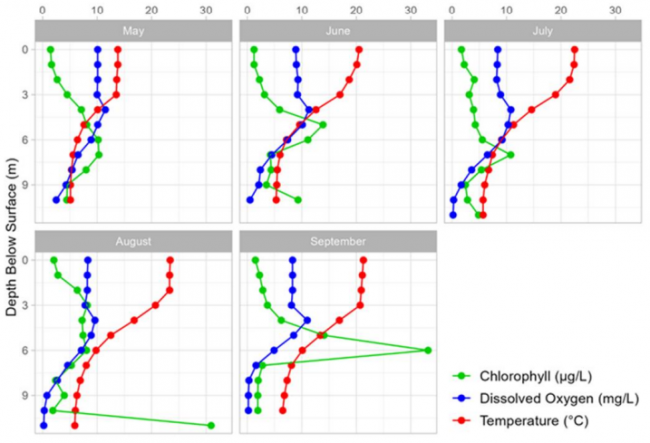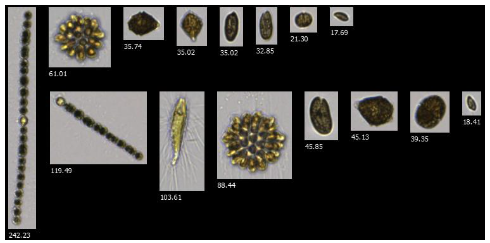
May – LEA’s water testing team collected the first fluorometer profile in mid-May. At that time, Back Pond was stratified. In the upper waters, fluorescence increased with depth until 6 m. An increase in dissolved oxygen can be seen right above where fluorescence was at its highest. This oxygen is likely produced by algae as a by-product of photosynthesis. In the deep waters, fluorescence began to decrease with depth.
June – In the upper waters, fluorescence values gradually increased with depth, reaching their peak near the thermocline at 5 meters. Another small increase in dissolved oxygen can be seen near thermocline, right above where algae concentrations were at their highest. In the deep waters, algae concentrations began to decrease with depth. Increased fluorescence values near the bottom are likely caused by interference from bottom sediments.
July – Warm surface waters provided more favorable growing conditions for algae, noted by slightly elevated fluorescence readings in the upper waters. Another increase in dissolved oxygen can be seen near the thermocline, right above a fluorescence peak at 7m. This is likely where the colder, denser water provided algae a place to “sit”. In the deep waters there was a sharp decline in fluorescence until the bottom, where increased fluorescence values are likely caused by interference from bottom sediments.
August – Warm surface waters continued to provide algae favorable growing conditions, noted by the elevated fluorescence values throughout the upper and middle waters. Fluorescence values were highest at 3 meters and six meters. In the deeper waters, fluorescence values decreased with depth. Increased fluorescence values near the bottom are likely caused by interference from bottom sediments.
September – Fluorescence values increased with depth and then starting at 4 meters, increased rapidly reaching high values and at 6 meters. Back Pond’s highest algae concentrations were recorded this month. In the deep waters, fluorescence values returned to low levels.
Synopsis: Algae concentrations are quite variable throughout the season with elevated readings in June and July and high readings in September. However, these higher concentrations were fairly deep (between 5 and 7 meters) and not in portion of the water column that people usually use. High readings in the bottom waters were likely caused by sediment interference.

Gloeotrichia echinulata (a type of cyanobacteria (blue-green algae) commonly found in low-nutrient waters) can be seen with the naked eye. Gloeo density is reported as a value ranging from 0 – 6, based on the number of Gloeo colonies seen through a Secchi scope. Higher values indicate more Gloeo colonies. Gloeotrichia echenulata colonies were not observed in Back Pond in 2023.

